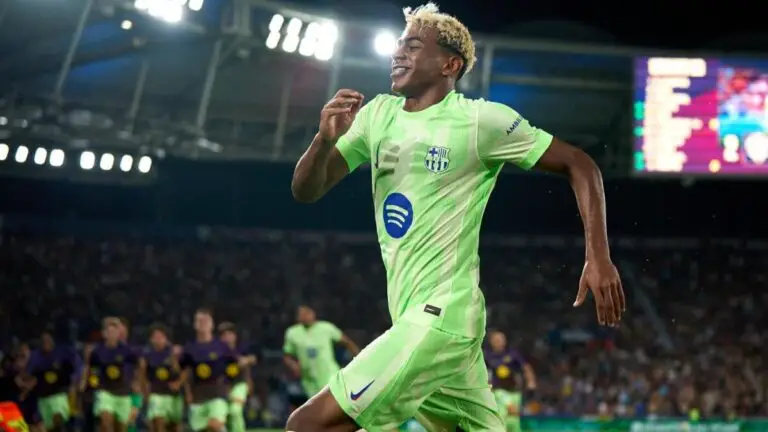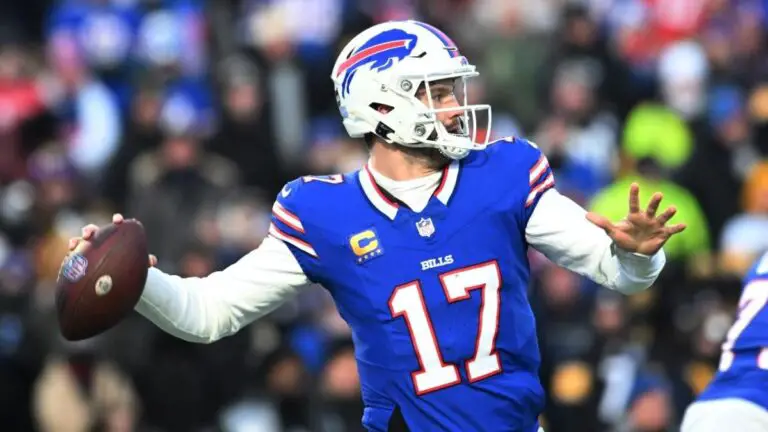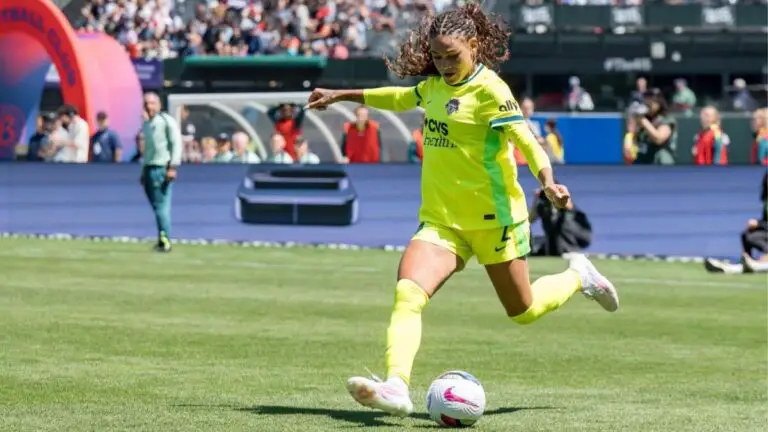
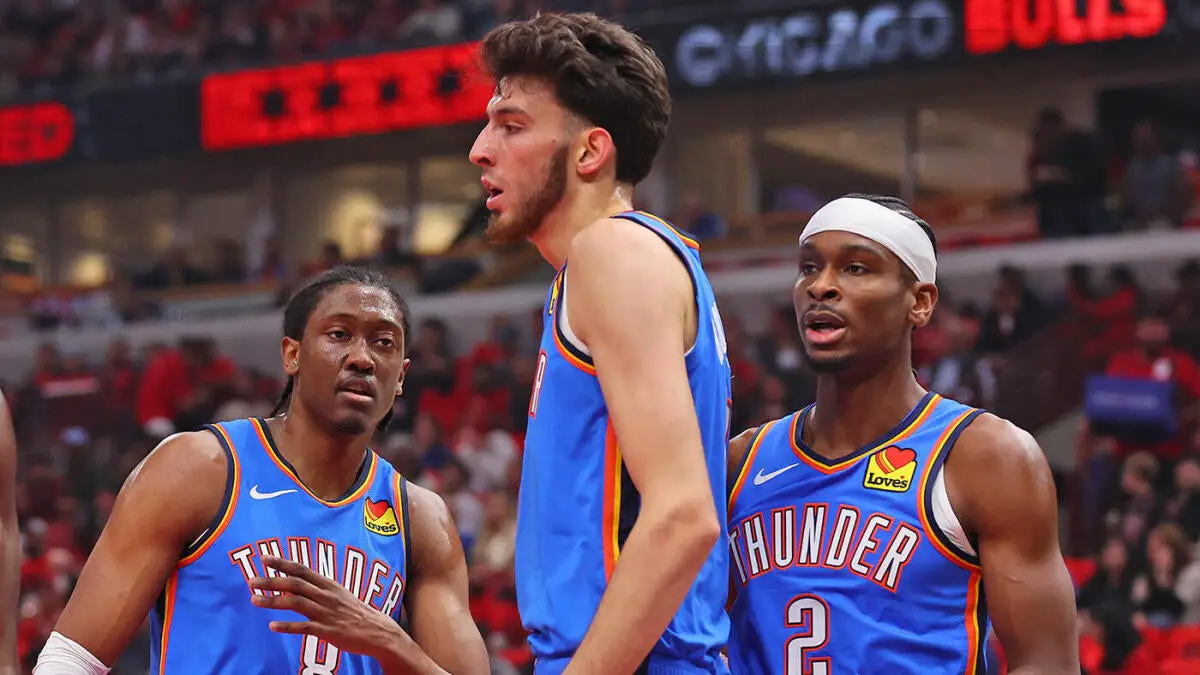
NBA’s second apron isn’t going to break up the Thunder, and here’s why it might actually help OKC
NBA’s second apron isn’t going to break up the Thunder, and here’s why it might actually help OKC
On Wednesday, the Oklahoma City Thunder agreed to a five-year extension with All-NBA forward Jalen Williams that could pay him up to $287 million. They had already re-signed Chet Holmgren on a similar five-year pact worth a potential $250 million, and league MVP Shai Gilgeous-Alexander tacked four years and $285 million onto his own contract earlier in July. All told, they committed up to $822 million in new money to their three best players. In doing so, they secured all three through at least the 2030-31 season.
It’s a terrifying proposition for the rest of the league. The Thunder are a 68-win defending champion that just posted the highest single-season point differential in league history. Their top three players are all between the ages of 23 and 26, and none of them are going anywhere. Few teams in history have ever been this well-positioned for sustained winning, even if we exist in an era designed to discourage sustained winning.
Chet Holmgren just signed a huge extension, but he potentially did the Thunder a favor while doing so
Sam Quinn
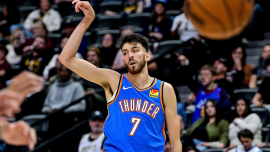
Be honest, you’re thinking about the second apron right now, aren’t you? It’s the boogeyman that’s been tearing up teams for the past several offseasons, the collectively bargained tool designed to prevent the sort of dynasty that the Thunder are trying to build. Oklahoma City just committed nearly a billion dollars to three players. The second apron has torn through cheaper rosters than that. That would suggest that it should be a source of hope for Oklahoma City’s competitors. If other teams can’t beat the Thunder, surely the second apron can, right?
Well, no. While there will be financial consequences for Oklahoma City’s recent spending that will manifest over time and could cause potential problems later, the second apron is not going to break up the Thunder. In fact, as terrifying as this sounds, the second apron might actually help the Thunder more than it hurts them. To understand why, we need to examine their finances and the actual impact of these new rules on roster-building.
Where are the Thunder now, and what are the rules to know?
First thing’s first: we need to define our terms. There are two rules you need to understand if you’re going to dig into Oklahoma City’s long-term finances.
- The repeater tax is an extra charge applied to the luxury tax when a team has paid the tax in at least three of the previous four seasons. Starting this season, the luxury tax formula has changed to make the repeater penalty significantly more punitive than it once was. Further, the higher a team’s payroll rises above the tax line, the more those tax rates rise. Therefore, if a team is consistently paying the tax and going well above the line to do so, it can expect to eventually pay hundreds of millions of dollars in taxes on top of its payroll commitments. This is essentially what happened to the Celtics. They only shed around $20 million in actual salary through their offseason trades, but doing so saved them roughly $200 million in payroll with the tax factored in.
- The second apron is a team salary threshold roughly 10% higher than the luxury tax line. Going above that line triggers a number of roster-building restrictions. Teams above the slightly lower first apron cannot use the full mid-level exception, take in more money than they send out in trades, or sign buyout players during the season who were previously making more than the mid-level exception. In addition, teams above the second apron cannot aggregate salaries in trades or use the taxpayer mid-level exception. When a team finishes a season above the second apron, its first-round pick seven years in the future gets frozen. This means it cannot be traded. If a team is over the second apron in two of the next four seasons, that pick automatically drops to No. 30 overall.
Got all that? Good. As the Thunder have neither paid the tax nor gone above the second apron yet, this means they are still four taxpaying seasons away from the repeater penalty and three second apron seasons away from seeing a first-round pick drop to No. 30 overall. This begs the question of when that cycle will actually start for them.
It won’t be the 2025-26 season. Oklahoma City currently has a full 15-man roster that is a bit less than $1.5 million below the tax line. That’s the benefit of drafting young stars. While Williams and Holmgren have both signed long-term extensions, they won’t kick in until the 2026-27 season begins. For now, they are both still underpaid on rookie deals, and that basically bankrolls the rest of the roster.
Things will get harder for the 2026-27 season. We won’t know just how much harder it will be until the 2025-26 season ends. Both Holmgren and Williams signed deals with reported potential values above the projected 25% max of $239 million. That’s because both deals include Rose Rule escalators, which allow players with their level of experience to jump up to 30% of the cap if they hit certain criteria: All-NBA, Defensive Player of the Year or MVP. They’ll both be paid well during that season, but just how well will depend on what sort of season they have.
At this stage, the luxury tax is likely to become unavoidable. However, the Thunder have an ace in the hole when it comes to ducking the second apron: team options. Isaiah Hartenstein ($28.5 million), Lu Dort ($18.2 million) and Kenrich Williams ($7.2 million) all have team options for the 2026-27 season. That’s around $54 million in money the Thunder can unilaterally offload if needed. That doesn’t necessarily mean all three are gone, but the Thunder can maneuver around the second apron as needed. Maybe some get their options declined and leave. Maybe they re-sign on team-friendly deals. Or maybe some are traded. But the point is that the Thunder can get off money as needed.
The 2027-28 campaign is when the second apron probably starts to come into play. That’s when Gilgeous-Alexander’s supermax deal kicks in, along with a potential rookie extension for Cason Wallace. By this point, the Thunder will likely have started to move veteran role players, which is part of their design. The idea here is to offload role players once they become expensive and replace them with their enormous stockpile of future draft picks. They will likely continue to add to that stock in the coming years. After all, even if they don’t want to pay for key veterans like Hartenstein or Dort, other teams surely will, and the Thunder will likely find ways to cash some of their players in for picks before they risk losing them for nothing. The idea here is to create a self-sustaining cycle: draft players, develop those players, benefit from those players, trade those players for more picks to start the cycle anew. Still, we can presume that there is some likelihood that the Thunder are above the second apron in either the 2027-28 or 2028-29 season, and potentially both.
Let’s say that’s the case. All of this would mean that the Thunder will have used up their three pre-repeater tax seasons and their two second apron seasons before picks start dropping to No. 30 by the end of the 2028-29 season. Conveniently enough, though, that’s the earliest point at which the current CBA can end. Both the players and owners can opt out of the CBA after the 2028-29 season, so the entire system might change before it even really starts to punish the Thunder.
We can’t anticipate that, though. There is also the chance the system remains largely intact. And that’s what we’re here to cover. So based on what we’ve covered so far, you’d expect the CBA to really start hurting the Thunder right around the end of the decade. But here’s the kicker… it’s probably going to hurt everyone else a whole lot more.
Ok… so how would the second apron help the Thunder?
Think about all of those second-apron restrictions we covered. Use of a mid-level exception. Matching salaries in trades. Adding buyout players. What they largely have in common is that they make it harder for a team to acquire players from the outside. But that’s the key to this. The Thunder don’t really need external additions. They already have a dominant team. That team is remarkably young, as no one on last year’s roster aside from Williams and Alex Caruso was above the age of 26. And when they need to replace anyone, they’ll just use the mountain of future first-round picks they’ve accumulated to do so through the draft. None of those restrictions is likely to impede them all that much. They’re primarily looking to draft and retain talent, rather than import it.
There is still one significant way in which the second apron is designed to discourage retention: the possibility of future first-round picks dropping to No. 30 overall. To a normal team, that’s tantamount to giving away an unprotected pick. While the team would still have a first-round pick, the automatic slotting would prevent it from tanking or using that year’s pick as a trade chip for further improvements. Remember, those frozen picks start seven years out. Most teams are not comfortable sacrificing the ability to rebuild seven years into the future for the sake of short-term contention. They just don’t have the ability to forecast where they’ll be at that point. Nobody wants to find themselves in a position in which their window closes before that pick comes up; they’re organically bad, but they can’t benefit from it because their pick is stuck at the back of the order.
But the Thunder aren’t a normal team. They don’t have any real reason to care if first-round picks in the mid-2030s drop to No. 30 overall. That’s a significant loss to a normal, win-now team. To a possible dynasty, it’s just the cost of doing business. They will presumably have such high championship odds so long as this core stays healthy that the optimal basketball move would be to shrug away the future and continue to invest in the present. Besides, Oklahoma City has so many picks from other teams that it can afford to lose value on its own. So in as much as any team can be, the Thunder are practically immune to the worst effects of the second apron at least as they exist in the current CBA.
You know who isn’t? Their competition. To catch up to Oklahoma City’s existing talent level, most teams reasonably need to add veteran talent from the outside. When that talent becomes expensive, most teams won’t have an endless cycle of prospects in place to replace them. Most of those teams have to build their rosters the normal way, the way that the CBA planned the second apron around. Those teams are extremely vulnerable to the aprons. They need flexibility to add money through trades and sign free agents. They have to be cautious about the second apron in ways that the Thunder don’t.
Just look at the team Oklahoma City beat in the Western Conference finals. The Timberwolves entered this offseason with three key potential free agents: Julius Randle, Naz Reid and Nickeil Alexander-Walker. They were able to retain Randle and Reid, but doing so took them practically up to the second apron. They elected to let Alexander-Walker leave and hope that Rob Dillingham and Terrence Shannon can replace him. If not, well, tough luck. Minnesota is out of tradable first-round picks. Even if they can, that likely wouldn’t be enough to bridge the gap between them and the Thunder. They’d need a significant addition to do that. That’s why they tried to get Kevin Durant. Part of the reason they couldn’t do so during the season was that both they and the Suns were second-apron teams, making trading together nearly impossible.
These are the dilemmas facing almost every other competitive team in the NBA. The Cavaliers are around $20 million above the second apron, and that’s after losing Sixth Man of the Year candidate Ty Jerome. Even if they wanted to try to trade for LeBron James, they’re functionally unable to do so without gutting their depth. Orlando just traded four first-round picks for Desmond Bane. In doing so, they set themselves to go above the second apron as soon as the 2026-27 season unless they move other contracts. Denver didn’t have Kentavious Caldwell-Pope when it faced Oklahoma City in the second round, largely because of the second apron. That might have been the difference between the Thunder winning and losing the 2025 championship.
The second apron isn’t helping the Thunder directly. It’s just hurting them far less than it’s hurting the teams that are trying to beat them. In that sense, its existence might actually be a net positive for them. The NBA set out to create a system meant to prevent sustained dominance from a single team. Instead, it created one in which building and maintaining a roster good enough to challenge that one, dominant team is going to be far more difficult than it used to be. There are a few teams following versions of the Thunder model. The Spurs and Rockets come to mind as teams less vulnerable to apron-related concerns than most, given how well they’ve both developed young talent and stacked future draft picks. But nobody has yet skirted the impact of the aprons as effectively as the Thunder.
So that brings us to the question fans of the other 29 teams are surely asking right now: is anything in this widely-disliked CBA going to be able to slow down the Thunder? The answer to that is… maybe.
So what are the real consequences of all this spending?
We’ve thus far focused primarily on the roster-building constraints created by the second apron. While those likely won’t have an enormous impact on the Thunder, the repeater tax easily could. It raises a very simple question: How many billions of dollars worth of player salaries and taxes is Oklahoma City’s ownership willing to pay in order to fund a possible dynasty?
You might be thinking that my use of the word “billions” is hyperbole. I assure you, it’s not. The luxury tax essentially works on a progressive bracket system. You start out paying a low rate per dollar in the earlier brackets, but those rates increase the deeper into the tax you go. The brackets change annually based on cap growth, but let’s use this season as an example. The first bracket covers every dollar spent between the tax line and $5,685,000 above it. Therefore, every $5,685,000 above the line a team goes, it enters a new bracket. Below is a table comparing the standard tax rate and the repeater tax rate.
|
$0-5,685,000 |
$1 for every $1 above the line |
$3 for every $1 above the line |
|
$5,685,000-$11,370,000 |
$1.25 for every $1 above the line |
$3.25 for every $1 above the line |
|
$11,370,000-$17,055,000 |
$3.50 for every $1 above the line |
$5.50 for every $1 above the line |
|
$17,055,000-$22,740,000 |
$4.75 for every $1 above the line |
$6.75 for every $1 above the line |
|
$22,740,000-$28,425,000 |
$5.25 for every $1 above the line |
$7.25 for every $1 above the line |
Every successive bracket after that tacks on another 50 cents. So let’s apply that to this season’s most expensive team. Right now, the Cleveland Cavaliers have a payroll of $226,287,886 with incentives factored in, according to Yossi Gozlan’s cap sheets. That sets them up, at least at present, to pay roughly $149 million in luxury taxes. But the Cavaliers are not a repeat taxpayer. If they were, that tax bill would vault up to around $226 million, right around where their payroll lands, making their total salary expenditure over $450 million, and that’s before even filling out their 14th roster spot. Something like this might have been sustainable for a year. Boston was in this range before its offseason moves and might have stayed there with a healthy Jayson Tatum. But doing so for several years at a time would cost billions of dollars in overall payroll.
This isn’t a problem for the Thunder yet. It will be down the line. Part of the irony here is that the NBA changed these tax rates specifically to make it harder on the NBA’s wealthiest, big-market owners. Joe Lacob (Warriors), Joe Tsai (Nets) and Steve Ballmer (Clippers) flexed their financial muscle to such an extent during the last CBA that the league was determined to make doing so significantly more punitive in the new one. But instead of them getting punished for their spending, it’s the small-market Thunder.
Furthering this irony? This isn’t even the first time something like this has happened. The 2011 CBA was designed to make it harder to build and sustain superteams after LeBron James and Chris Bosh joined the Miami Heat. Before that, the tax was merely a dollar-for-dollar charge. But in 2011, the league adopted the progressive structure still in use today. The first team to face punishment for this was the Thunder, as their wariness of the potential tax implications played a role in their decision not to offer James Harden a max contract after the 2012 Finals. They ultimately traded him to Houston thereafter.
That has led some fans to believe Oklahoma City’s ownership is cheap. That’s not entirely fair. The Harden situation was more complex than just the tax concerns. The Thunder paid considerable tax bills during the Russell Westbrook-Paul George years, and they’ve had years to prepare for what’s about to come. They’re not going to shy away from the tax at first. But this team is so young and therefore positioned to be so good for so long that eventually, ownership could very easily reach a breaking point. Very few owners are prepared to pay the repeater tax indefinitely, especially if the team plans to stay far above the line.
So based on everything we’ve covered, the CBA probably won’t do much to deter the Thunder through the 2028-29 season. They’ve assembled enough young talent to plausibly keep competing for championships into the 2030s. The question will be whether or not ownership is willing to pay for them to do it.
NBA,Oklahoma City Thunder,Kevin Durant,Isaiah Hartenstein,Minnesota Timberwolves,Ty Jerome,Los Angeles Lakers,Cleveland Cavaliers,Brooklyn Nets,Los Angeles Clippers,James Harden,Houston Rockets,LeBron James,Phoenix Suns,Shai Gilgeous-Alexander,Alex Caruso,Julius Randle,Nickeil Alexander-Walker,Golden State Warriors,Chet Holmgren,Kenrich Williams,Cason Wallace,Rob Dillingham,Naz Reid,Kentavious Caldwell-Pope,Boston Celtics,Jalen Williams,Chris Bosh,Jayson Tatum,Miami Heat,Desmond Bane,San Antonio Spurs

